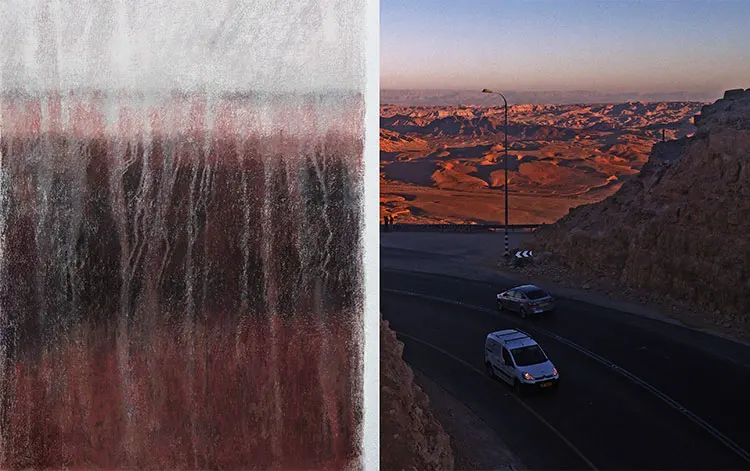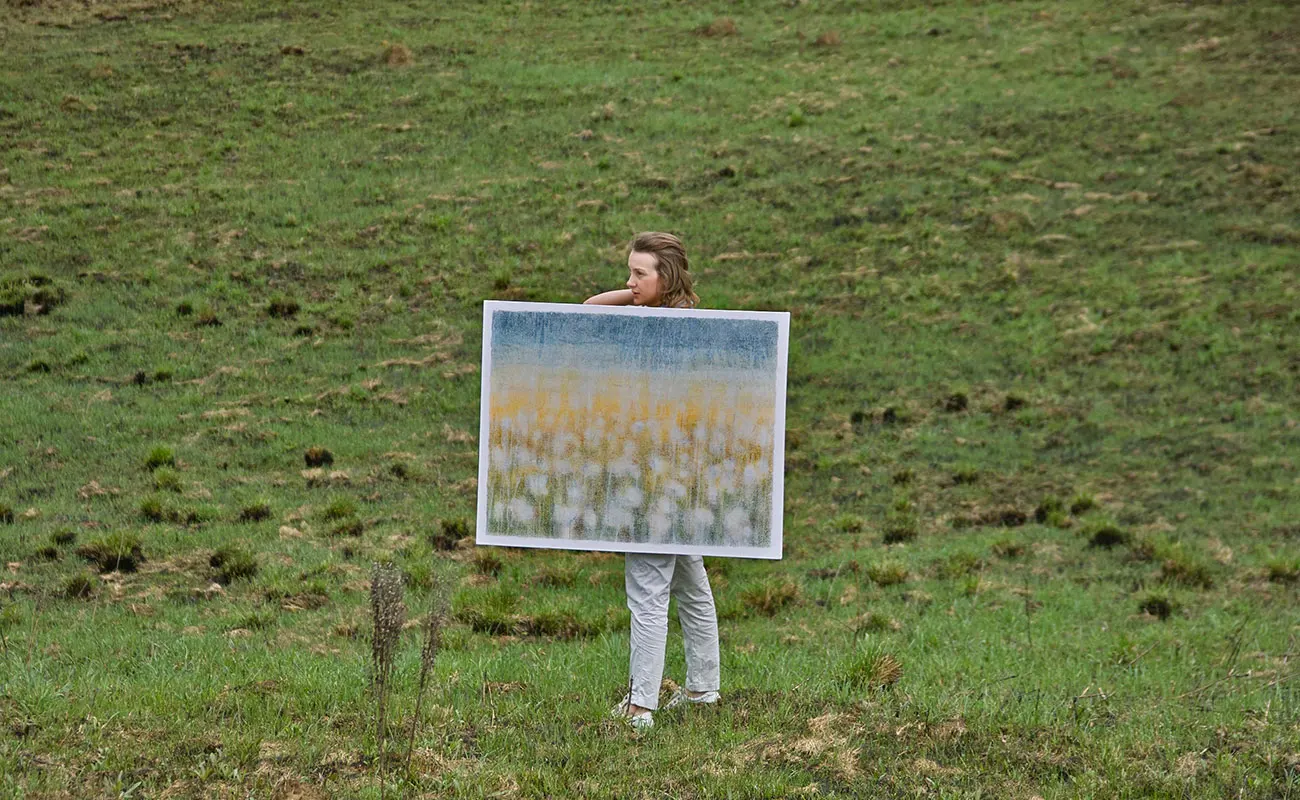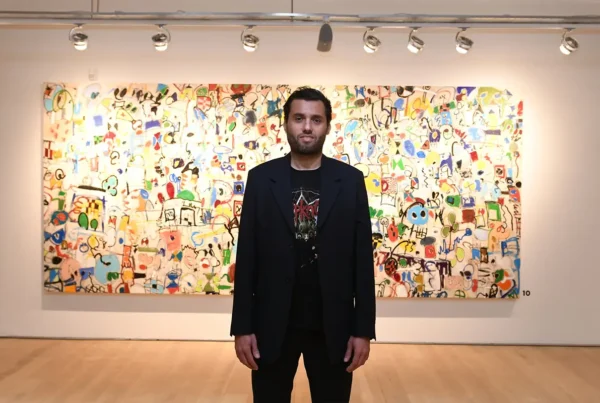“I consider my works to be a projection of the full connectedness of my ‘inner landscape’ with the landscape of the place.”
The Artistic Journey of Yulia Mashkova: From Designer to Artist
Yulia Mashkova, a contemporary abstract artist, holds a degree in Spatial Design from the prestigious Saint Petersburg Stieglitz State Academy of Art and Design. Prior to her immersion in the realm of fine arts, Mashkova worked as an urban and spatial designer, which influenced her artistic approach.
Central to Mashkova’s creative exploration is the concept of space. Her groundbreaking project, The Space of Identity, employs her handprint as an artificially crafted archipelago. The unique topographic map formed by the lines and curves of her palm establishes an implicit yet profound connection between an individual’s identity and the surrounding environment.
The intricate relationship between a person and space has consistently piqued Mashkova’s artistic curiosity. The inspiration for her subsequent projects, both professional and independent, stems from the spaces she has visited and the places she has traversed. She is drawn to the atmosphere of a space, its inherent spirit, and the contemplation of its unadulterated beauty or inherent contradictions.
Mashkova’s distinctive technique involves the use of soft pastels and seawater on canvas to create ethereal, abstract landscapes. Her work represents a harmonious union between her inner landscape and the external environment. This connection evokes a profound sensation, akin to witnessing one’s own portrait within the landscape or discovering personal revelations through nature. René Magritte’s painting Seducer, in which the silhouette of a ship dissolves into the sea waves, aptly captures the essence of this feeling.
Mashkova has previously showcased her artwork through open-air exhibitions in bucolic settings, inviting trees, fields, lakes, and wind to bear witness to her creations. Passersby were encouraged to attend these unconventional events, where the unexpected exhibition space sparked their curiosity and provided an opportunity for genuine observation, reflection, and sharing of emotions and thoughts. This immersive experience facilitated a deeper connection with personal memories and associations linked to various familiar or imagined spaces.

Inspirations and Motivations of Yulia Mashkova’s Artistic Expression
Yulia Mashkova has devoted her life to the art of drawing. A decade ago, she began crafting her unique “washed-up by the waves” landscapes and spent considerable time collaborating with architectural studios to integrate her work into various interior design projects. However, it was only when Mashkova gained a profound understanding of her motivations and the messages she sought to convey through her abstract pieces that she confidently embraced the title of an artist. This epiphany marked a significant turning point in her creative journey.
Mashkova perceives her own work as an extension of the masterpieces crafted by the artists she admires, such as the emotive pieces by Hans Severding, Anselm Kiefer, and Dansaekhwa. She is captivated by the psychological nuances expressed in artistic imagery, from the symbolic representations found in Japanese haiku to the melancholic metaphors in Federico Garcia Lorca’s poetry. The enchanting landscapes in Wim Wenders’ road movies and the expansive, misty fields portrayed in Theodoros Angelopoulos’ cinematography hold a special place in her heart. Furthermore, she admires the meditative architecture of Peter Zumthor, whose creations harmoniously correspond with the spaces they inhabit. Mashkova believes that a similar driving force—an intense desire to express one’s inner state through an identity with the place, space, or landscape—motivates both her and these esteemed artists.
Christopher Day’s writings, particularly his book “Spirit and Place,” have also played an instrumental role in shaping Mashkova’s artistic development. The insights gleaned from his work have transformed her perception of space, refining her approach to exploring it and enabling her to comprehend the unique spirit of any given locale.
Reflecting on her painting “Whales,” Mashkova regards it as the most poetic of all her creations. Birthed in October 2017 during the first month of her motherhood, the piece embodies the complex array of emotions and sensations she experienced as a new parent. In this period, she found herself enveloped in an unusual state, one aptly captured by a lyric from David Bowie’s “Space Oddity”: “I’m stepping through the door. And I’m floating in the most peculiar way.”

The Creative Process of Yulia Mashkova’s Art: Washed-out Landscapes and Symbolic Links
During the period of breastfeeding her daughter, Yulia Mashkova found herself immersed in profound contemplation about the infinite timeline that preceded her and would extend far beyond her daughter’s life. She came to perceive the nourishing milk from her body as a symbolic link connecting her to her mother, her grandmother, and generations beyond. This realization stirred an intense sensitivity within her, akin to a mystical revelation.
In that same period, Mashkova learned of a solitary whale that had strayed into the Baltic Sea and become trapped in the Gulf of Finland, far from its natural Atlantic Ocean habitat. This extraordinary occurrence had never been recorded before, and it deeply resonated with the artist. As she followed the news about rescuers attempting to aid the lost whale, she felt compelled to take action in her own way. She reimagined the whale’s story, creating a work that depicted two large whales exhaling as they journeyed through a vast green ocean. This artistic expression enabled her to release the story and find a sense of peace.
Mashkova’s creative process begins with the vibrant hues of her dry pastel and the aroma of saltwater. The materials she employs serve as central characters, infusing her art with elements of magic, mystery, and alchemy. Drawing inspiration from nature, she starts by painting blocks of color that evoke a sense of something emerging from her observations.
Mashkova identifies with the words of renowned artist Pierre Soulages, who said, “I never know what I am drawing, so I learn what I am looking for from what I do.” This sentiment resonates strongly with her own approach, as she never sets out with a specific idea to express on canvas. Instead, she follows a nebulous inner feeling or impulse that irresistibly draws her to the medium.
The core of Mashkova’s practice lies in the slow, repetitive motions of washing out pigments with seawater and layering the canvas with colored pastel strokes. This meditative process allows her to listen to her inner self, distance herself from her ego, and trust in the uncertainty of the outcome. Working with water, an unpredictable yet central element of her process, helps her relax and accept the final result.
Mashkova believes that time has a way of revealing the essence of things by shedding their superficial layers. The series of actions she repeats within her creative process serves a similar purpose, allowing her paintings to undergo experiences reminiscent of an aged, weathered wall, the battered hull of a boat, or a time-worn antique rug.
The culmination of her artistic journey arrives when Mashkova perceives her painting as an object of meditation, a reflection of the initial emotion and dialogue between herself and the natural forms that inspired the work.

Yulia Mashkova’s Artistic Niche: Finding Inspiration in Nature and Art
Yulia Mashkova possesses the ability to establish a comfortable workspace for herself in nearly any location, as the materials required for her artwork are easily accessible and transportable. The artist values optimal lighting and a serene environment to facilitate her creative process, with no distractions or interruptions. Mashkova finds it especially soothing to have the presence of water, either visible or audible, as she works on her art.
Currently residing in Montenegro near a yacht marina, Mashkova enjoys the strong winds that often blow through the area, which seem to fuel her creativity. At present, she has found an ideal location to cultivate her art.
Mashkova harbors a cherished project idea: to create a series of paintings inspired by the poetry of her beloved Federico García Lorca. The artist is deeply moved by his vivid images and metaphors and envisions a collection of works that convey her interpretation of his poetry in a poignant, beautiful, and tender exhibition.
Aware of the Federico García Lorca Centre in Granada, Spain, which hosts various cultural events to promote the author’s legacy through contemporary art, Mashkova would be delighted to collaborate with them in the future.
A turning point in Mashkova’s artistic journey was her decision to delve into the experiences of various abstract artists and landscape photographers to whom she felt a connection. By examining their artworks, exhibitions, biographies, and related articles, Mashkova sought to carve out her own niche among those renowned figures and identify a compatible art segment that resonated with her mindset, philosophy, and aesthetic preferences. She uncovered numerous artists she admires and aspires to emulate, including Akihito Takuma, Minjung Kim, Richard Serra, Lucio Fontana, and Rob Sweere. Each piece of information encountered during her research broadened her horizons and bolstered her self-confidence, imbuing her with a sense of shared identity and revealing potential paths for professional artistic growth. Mashkova believes this approach to be invaluable for aspiring artists in their early stages of development.






